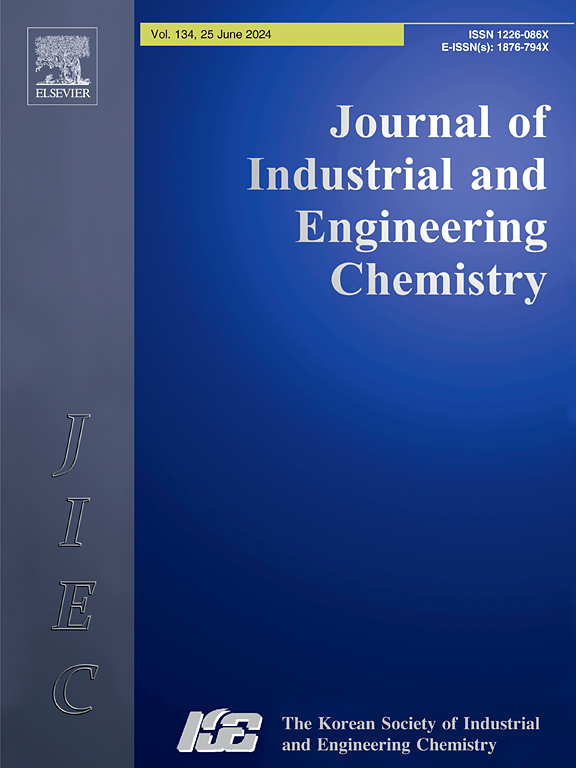IF 5.9
3区 工程技术
Q1 CHEMISTRY, MULTIDISCIPLINARY
Journal of Industrial and Engineering Chemistry
Pub Date : 2024-11-27
DOI:10.1016/j.jiec.2024.11.051
引用次数: 0
摘要
本研究通过在深共晶溶剂(DES)复合物存在下煅烧铁/锌前驱体,制备了以缺陷铁掺杂氧化锌纳米粒子(NPs)为支撑的自组装超细纳米Fe2O3簇。在煅烧过程中,铁/锌前驱体与 DES 复合物的分解产生了表面缺陷,同时催化剂的结晶度也得到了改善。在氧化锌晶格中加入铁原子后,氧化锌纳米粒子的六方菱面体结构得以保留。值得注意的是,由于 DES 中成核中心的改变,加入铁原子后,粒径从 32 纳米减小到 22 纳米。电子顺磁共振分析表明,在氧化锌基质中掺入的 Fe3+ 原子会在 g 值为 2.0 时产生一个宽峰。这些掺杂的 Fe3+ 原子在 NPs 表面产生了额外的活性位点,从而延长了 Fe2O3/ZnO 纳米复合材料的光致发光寿命。因此,优化后的 Vo-Fe/ZnO 纳米复合材料对罗丹明 B (RhB) 的降解效率达到 95%,速率常数 (k) 为 0.0755 min-1。此外,纳米复合材料在降解 RhB 方面具有可见光光-芬顿活性,其 k 值为 0.0069 min-1。本文章由计算机程序翻译,如有差异,请以英文原文为准。
Fe incorporation and modulation of oxygen vacancies in ZnO nanoparticles for photocatalytic degradation of Rhodamine B
In this study, self-assembled ultrafine nanoclusters of Fe2O3 supported with defective Fe-doped ZnO nanoparticles (NPs) prepared via calcination of a Fe/Zn precursor in the presence of deep eutectic solvents (DES) complex. During the calcination process, surface defects are generated through the decomposition of Fe/Zn precursor with DES complex, simultaneously crystallinity of catalysts improved. The hexagonal wurtzite structure of ZnO NPs is retained after the incorporation of Fe atoms into the ZnO crystal lattice. Notably, the particle size is reduced from 32 to 22 nm after Fe incorporation due to alterations in the nucleation center in the DES. Electron paramagnetic resonance analysis reveals a broad peak at a g value of 2.0, attributed to Fe3+ atoms doped into ZnO matrix. These doped Fe3+ atoms create additional active sites on the surface of NPs, leading to an extended photoluminescence lifetime of the Fe2O3/ZnO nanocomposite. Consequently, the optimized Vo-Fe/ZnO nanocomposite achieves a 95 % removal efficiency for Rhodamine B (RhB) degradation with a rate constant (k) of 0.0755 min−1. Additionally, nanocomposite shows visible light photo-Fenton activity for RhB degradation with k of 0.0069 min−1.
求助全文
通过发布文献求助,成功后即可免费获取论文全文。
去求助
来源期刊
CiteScore
10.40
自引率
6.60%
发文量
639
审稿时长
29 days
期刊介绍:
Journal of Industrial and Engineering Chemistry is published monthly in English by the Korean Society of Industrial and Engineering Chemistry. JIEC brings together multidisciplinary interests in one journal and is to disseminate information on all aspects of research and development in industrial and engineering chemistry. Contributions in the form of research articles, short communications, notes and reviews are considered for publication. The editors welcome original contributions that have not been and are not to be published elsewhere. Instruction to authors and a manuscript submissions form are printed at the end of each issue. Bulk reprints of individual articles can be ordered. This publication is partially supported by Korea Research Foundation and the Korean Federation of Science and Technology Societies.

 求助内容:
求助内容: 应助结果提醒方式:
应助结果提醒方式:


